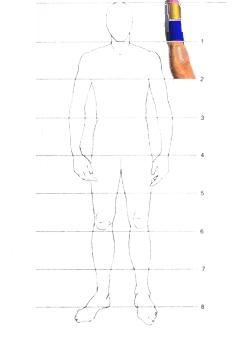Measuring The Figure
Observation of the figure can be facilitated by visually measuring the figure. This can be done by using a measuring stick or pencil.
Measuring the Figure: Try the process below. Always keep your arm straight and hold the pencil the same way each time you measure or significant distortions will occur.
- Grip the pencil in your fist leaving the thumb free.
- Hold your arm out straight in a relaxed fashion with the thumb and pencil protruding straight up.
- Close one eye and measure off the distance from the top of the head to the chin. Move the top of your thumb down until it lines up with the chin.
- Now hold that measurement from the top of the pencil to the thumb and line it up with the bottom of your last measurement.
- Repeat this process and count how many head lengths make up the distance from the top of the head to the back of the heel.
- This will give you the overall length of the figure in relation to one head.
- Repeat this with the width, only turn your pencil to the side (90 degrees from the last orientation).

Standard Proportions: The following is a list of standard bodily proportions that can give you a good idea of ideal proportions.
- The human figure is an average of 7 heads high.
- The width from shoulder to shoulder is 3 heads width.
- The distance from the hip to the toes is 4 heads.
- The distance from the top of the head to the bottom of the chest is 2 heads.
- The distance from the wrist to the end of the outstretched fingers of the hand is 1 head.
- The length from top to bottom of the buttocks is 1 head.
- The distance from the elbow to the end of outstretched fingers is 2 heads.
All these "ideal" measurements vary from model to model. Check out other figure drawings that you have done and see if adjusting these increments helps.
Leonardo da Vinci also used ideal measurements when he was working on the human figure. The drawing entitled Vitruvian Man is based on a model of ideal proportions established by the ancient Roman Vitruvius.
Leonardo da Vinci's (1452 - 1519 CE) "Proportional Study of Man in the Manner of Vitruvius was drawn about 1487 CE. Leonardo was an ideal "Renaissance Man" who studied almost everything. He even dissected human bodies to see how they were put together. Although he focused on the practical workings of nature, he also had an idealized sense of humanity that came from the Renaissance preoccupation with Roman antiquity. This image came out of this interest. Renaissance thinkers saw a kind of mathematical perfection in the human form. This image depicts the human body within the ideal form of the circle and within the perfect proportions of the square.

Tip here.